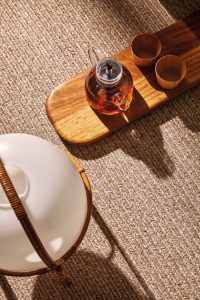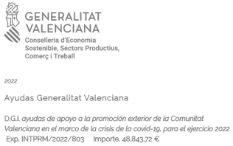«Good design lies in a balance, a balance between aesthetics and functionality»
«Mediterranean design is something difficult to explain in words, but the eye detects it quickly. It is in the way we respect the materials, the colour of the objects, the way we use light, the friendliness of the forms»
His beginnings, his traits as a designer, his vision of the profession, the good heart that accompanies his recently launched project with Sanycces or the revolution in the world of bathrooms weave this talk with the Canarian designer Jorge Herrera.
Jorge Herrera, born in Las Palmas, but Valencian by adoption, immersed himself in design from "ignorance" and almost without realising it, although his vocation runs in his family. From that creativity that has enveloped him since childhood. He made his first design in high school. It was a customised bookshelf. Something "unconscious", he explains. But there was potential. Since 2008 he has been the soul of the internationally awarded Jorge Herrera Studio, based in Valencia. His multidisciplinary profile allows him to tackle all phases of the creative process. A firm advocate of detail, of products that evoke sensations and of intelligent, simple and practical solutions, he conceives design as "a tool to make the complex easy". Essentialism is one of his traits as a creator. "I look for the essence of the product to highlight it with the maxim that form follows function". It is here that "my Mediterraneanness comes in". That which gives an emotional aspect to his designs. A different pigmentation that evokes his latest double project: Calma and Tempo, two bathtubs that explore the Mediterranean vision of bathing and with which Herrera debuts his collaboration with Sanycces. He has, he insists, "a good hunch".
Where does your passion for design come from? How did you approach the profession?
It started when I was a child. I come from a creative family. My grandfather, although he wasn't a professional shoemaker, had a garage and a workshop where he made his creations, and we were always playing at inventing things with materials like wood or leather and with broken radios or televisions. My mother was very restless. She painted and did sculpture. My sister is also a painter. So it runs in the family.
Do you remember your first design?
It was a bookshelf with a desk that I made in high school, made to measure and completely customized. It was what I wanted for my room. Anyway, I designed it a bit unconsciously. It was during those years that I realized that I liked technical disciplines, such as those related to drawing for example. At university I hesitated between studying Architecture, Design or Engineering. I ended up going into Engineering and after two weeks I realized that it wasn't what I wanted and I changed to Design. I am from the first class of Industrial Design at the University of Las Palmas de Gran Canaria. My interest in the profession was born completely out of ignorance, because at that time Industrial Design as an education in Spain was unknown, especially in the Canary Islands.

You were born in Las Palmas, but you are Valencian by adoption, what does Mediterranean design mean to you?
Mediterranean design is something difficult to explain in words, but the eye detects it quickly. It is in the way we respect materials, the colour of objects, how we use light, the kindness of shapes... It has to do with how we face life, and how important time is for us. In my case, I feel halfway between an emotional design that we practice more in countries such as Spain or Italy; and the rational, with its epicenter in Germany. As a designer, I am Mediterranean-German.
A description for this binomial...
Well, I don't consider myself a minimalist, but essentialism is one of my pillars, seeking the essence of the product and highlighting it with the maxim that form follows function but not from such an orthodox perspective as is practiced in Germanic design. That's where my Mediterraneanness comes in. That's where the Mediterranean traits come in, which give the products an emotional aspect, a different pigmentation: the connection with people. In this sense I see myself as more emotional but without being provocative. A Mediterranean essentiality.
Good design vs. bad design, how do they differ?
Good design has to work and bad design doesn't work. It is not useful, it can break, it can be badly dimensioned, it can be so heavy that it cannot be transported, etc. Good design lies in a balance between aesthetics and functionality. It does not have to be the most aesthetically polished. In other words, it is not so much about aesthetics but about other factors: function, form, manufacturability, costs, transport, raw materials, recyclability, footprint...
Functionality and Mediterranean style are very present in your collaboration with Sanycces, for which you have designed two bathtubs, Calma and Tempo. What has the experience been like?
The relationship with the firm has been very friendly, we've connected from the very first moment. They have given me a lot of room to work, a lot of freedom. We have been building the project between the two of us. In design there is also a part of your relationship with the client, whether or not you are in the same boat, and if you manage to create a team, as has been the case here.
What contribution can companies like Sanycces make to design?
Their contribution can be immense because they can take a new path, without having to follow in anyone's wake. They represent another way of looking at the bathroom world, very committed to design and they are providing high-value products without losing their essence as a close, family-run company.
What is this new way of understanding the bathroom like?
The bathtub in these times is linked to a slow movement, of using them for those places where you can enjoy your time. Today it has a more contemplative sense. Calma and Tempo fit in with the new meaning that bathtubs are acquiring in today's world. In that more leisurely way of understanding life.
But it is no longer about that idea of a spa more related to a luxurious vision of bathing. It's about self-care and connection, about holistic health. That's why we find bathtubs everywhere, even outside the bathroom. For example in the bedroom or in areas of the house with a connection to the outside. The bathroom has become like the kitchen and the living room: those fine lines that separate the rooms are disappearing.
In the end, two came out of one original design. Tell us: what is Calma and what is Tempo like?
Calma is a bathtub that will be timeless. With simple, pure lines and volumes that connect with the user, it conveys something: calm. It is purity and a touch of Zen. Because of its enveloping and concave shape, with the shape of a container and a bowl, it is a bathtub that is more conceived for resting, tucking in, even more for being with a partner. Calma has different leg options that give the sensation of floating and an exclusive tray that updates a classic way of using the bathtub. This creates a supportive space that helps to explore a wellness dimension of bath time.
And Tempo is that rope that can catch time. It is a bathtub that, without wanting to be transgressive, is different, because there is nothing like it on the market. It represents that contact with nature, with the Mediterranean. Its peculiarity is the incorporation of the textile, through an enveloping rope that you can touch while you bathe and that is the mooring to this natural and temporary dimension. It is also characterized by its personalized range of colours. Its geometry, with a straighter backrest, was created to meet a functional need. It is a more utilitarian bathtub, but without losing its poetry.
How has the pandemic changed our relationship with the bathroom?
We now make much more intensive use of the bathroom, largely for hygiene. Its function has been enhanced.
Complete the sentence: "For me the bathroom is..."
Light and warmth. Because I believe that bathrooms have to have natural light, I can't conceive of it any other way, and being from the Mediterranean it should be more important. And warmth is key, it is a place for intimate moments.


